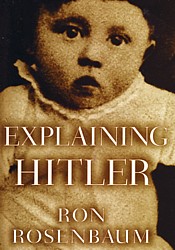Strong Points (back
to top)
However, not all of Rosenbaum's research and assertions are filled with
flaw. His writing is very colorful and one cannot but love the way he
goes on to describe his encounters with his interviewees. Walter Sundberg,
professor of Church History and reviewer of Rosenbaum's work, explains
this as "the typical gusto of [a] contemporary journalist" (Sunderberg,
7). John Gross says "it is both thoughtful and deeply felt" (Gross, 12),
and Lawrence Langer posses it as a "picaresque excursion." (Langer, 99).The
ability to present the reader with vivid descriptions of his encounters
with his interviewees is what I was most drawn to, his ability to somehow
make the reader know who his interviewee is firsthand using his journalistic
abilities.
A good example of this is the encounters with filmmaker Lanzmann. Lanzmann
and Rosenbaum are to meet at Lanzmann's mansion for the interview and
Rosenbaum was not given the codes to enter through the gates. After much
attempts at calling Lanzmann, Rosenbam is about to leave back to his hotel
room, therefore decides to leave a message in which he states that he
is about to leave, but before doing so he gives one last call. The last
call is answered not with an apologetic Lanzmann, but with an attacking
one who comes close to calling Rosenbaum a liar. This anecdote is not
simply stating Rosenbaum's hardships in attempting to get interviews from
so many opposing theorists it lends itself as insight into the very nature
of Lanzmann. He is the one who attacked Dr. Micheels, an Auschwitz survivor
and psychoanalyst at Yale School of Medicine, who tried to explain why
the Holocaust happened. What is disturbing about this picture is not the
fact that Lanzmann is attacking a Holocaust survivor wanting to know why
he had undergone such hardships, but the fact that Lanzmann is the director
of Shoah, a highly respected nine-hour long documentary about the
Holocaust. Lanzmann is therefore someone who you think would have the
capacity to understand a survivor's position in wanting to ask why. Anecdotes
such as the one I've explained fill Rosenbaum's book, one that, although
digressing from academic thought, is not boring.
Another strong point of Rosenbaum's book is his discovery of the archives
of the Munich Post, the aggressive anti-Hitler newspaper of the
1920s and early 1930s that was presumed lost. His insight about what once
was thought a non-attacking, conformist German society now shines light
about what this newspaper wrote about Hitler and his Nazi Party, and demonstrates
that not everyone in Germany fell under Hitler's powerful spell. Rosenbaum
obviously has some inclination to demonstrate how valiant and martyr-like
the reporters at the Munich Post were because he himself is a journalist.
Nonetheless, the finding is remarkable. Rosenbaum declares that the Post's
journalists were
"... the first to focus sustained critical attention on Hitler…the
first to tangle with him, the first to ridicule him, the first to investigate
him, the first to expose the seamy underside of his party, the murderous
behavior masked by its pretensions to being a political movement…the
first to attempt to alert the world" (Rosenbaum, 37).
There is certainly a lot of emphasis placed on the Munich Post as being
the first at everything, and Rosenbaum is correct to recognize it for
that. These reporters certainly would have been more influential if they
had not been silenced so quickly by Hitler and his party. Yet they did
not leave without a fight. As Rosenbaum explains, their final headlines
read: "Hitler Against the Munich Post," "On His Bell Again,"
"Warm Brotherhood in the Brown House: Sexual Life in the Third Reich,"
and "The November Criminals: What Hitler Doesn't Tell His Listeners."
(40-53). What is perhaps most insightful about the Post reporters, Rosenbaum
explains, is that they were able to see through Hitler's charade and made
public his "signature crimes," (51) blackmailing and counterfeiting true
history. Gross states that Rosenbaum is enticed to believe that "Hitler
was a gangster first and an ideologue second," however this is not Rosenbaum's
"settled opinion" about Hitler's nature, but is nonetheless a forceful
one (Gross, 12).
Perhaps an even stronger argument for Rosenbaum's Explaining Hitler
is his ability to raise questions within the reader. Thought-provoking
statements such as Dr. Micheels'"'Da soll ein warum sein': there must
be a why" (Rosenbaum, 276), or the final sentences of the book:
"in attempting to explain Hitler: to seek explanation but also resist
explanation…to resist the way explanation can become evasion or consolation…to
resist making the kind of explanatory excuses for Hitler that permit
him to escape [emphasis added]" (395).
To me this can be translated into never forgetting to ask why things
happen in life, but also never giving or settling for an answer that allows
the perpetrator to get away or gain victory. |
